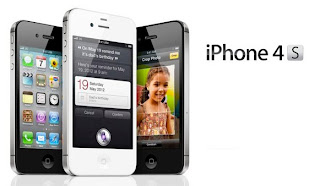 Given that the last two versions of the iPhone aren't going away any time soon, and they all support the new iOS 5 operating system, it's helpful to know the differences between the three phones. Not only is there a price difference, but the technical specs are different as well. As a quick note, the new Siri voice assistant feature is only included on the iPhone 4S.
Given that the last two versions of the iPhone aren't going away any time soon, and they all support the new iOS 5 operating system, it's helpful to know the differences between the three phones. Not only is there a price difference, but the technical specs are different as well. As a quick note, the new Siri voice assistant feature is only included on the iPhone 4S.Price of the iPhone
With a two-year contract, the iPhone 3GS with 8GB storage is free. The iPhone 4 with 8GB is $99, again under a two-year contract. The iPhone 4S with 16GB is $199; there is no 8GB model of the iPhone 4S. If 16GB of storage on your iPhone 4S isn't enough for you, you can upgrade to 32GB for $299 or 64GB for $399. Again, all of this is based on signing a standard two-year contract.
Put another way, the iPhone 3GS is free, and you're spending $12.37 per GB of memory on an iPhone 4. With the iPhone 4S, you're spending $12.43 per GB for the least expensive phone, $9.34 per GB for the 32GB model, but only $6.23 per GB on a 64GB iPhone 4S.
Carriers and bluetooh
If you're using an iPhone 3GS, you're stuck with AT&T. The iPhone 4 and iPhone 4S will be carried by both AT&T and Verizon ... but also Sprint! This is especially exciting since Sprint is offering unlimited data plans.
The iPhone 3GS and iPhone 4 both use bluetooth 2.1, but the iPhone 4S uses bluetooth 4.0. While this wireless upgrade won't make a difference for a while, it's nice to know the iPhone 4S is already forward compatibile.
Camera and Video
The iPhone 3GS has a 3 megapixel camera that can autofocus. The iPhone 4 camera is 5 megapixels, enjoys an LED flash, a backside illumination feature, and a four-element lens; the iPhone 4 also has a front-facing VGA camera. The iPhone 4S dwarfs them both with an 8 megapixel camera, an LED flash, backside illumination, a five-element lens, faster shooting speed, and face detection; it's also got a front-facing VGA camera.
Video becomes a big deal with these camera improvements. The 3GS can record 480p video. The iPhone 4 records at 720p and includes an LED light. The iPhone 4S is another step up, recording 1080p video and still sporting LED lighting while also adding image stabilization.
Display quality
The iPhone 3GS is a 480-by-320 display. In this regard, the iPhone 4 and iPhone 4S share the same specs: 960-by-640 resolution. The iPhone 4 and iPhone 4S offers a Retina Display, which is a way of saying it has an incredibly high pixel density. This density is responsible for amazingly crisp, beautiful resolution on the iPhone's screen.
Battery life
The iPhone 3GS gets 5 hours of talk time on 3G networks or 12 hours of talk on old 2G networks. On the iPhone 4, you get 7 or 14 hours of talk time. On the iPhone 4S, Apple squeezed out a little more battery life with 8 hours on 3G networks and 14 hours on 2G networks.
Interestingly, standby battery life is one of the places where the iPhone 4S is weaker than its predecessors. While the iPhone 3GS and iPhone 4 both expect about 300 hours of standby battery life, the iPhone 4S only gets around 200 hours. This difference probably won't be a deal-breaker for anyone, but it does likely speak to the power requirements of the A5 processor.
Presentation and color
The iPhone 3GS is only available in black now. If you want a white iPhone, you'll have to pick up an iPhone 4 or iPhone 4S. These two models are available in black or white.
The iPhone 4 and iPhone 4S are nearly identical in both size and weight, with the iPhone 4S tipping the scales at a scant tenth of an ounce heavier. The iPhone 3GS is a slightly bigger than its compatriots; while all three phones are 4.5" tall, the iPhone 3GS is 0.09" wider and 0.11" thicker. Overall the size differences between the 3GS and the 4 and 4S are fairly small, with the far more noticeable difference being the design aesthetic between the 3GS's rounded back and the flat back and curved corners of both the 4 and 4S.
Under the hood
The iPhone 3GS uses an old Samsung processor. The iPhone 4 uses a chip called the A4, the same chip used in the original iPad, while the iPhone 4S uses a dual-core A5 chip, the same chip found inside the iPad 2. The important thing here is that the iPhone 4S has a much more powerful processor than the iPhone 4, which was already a big upgrade over the iPhone 3GS.
The bottom line
The easiest way to understand the difference in these specs is that the iPhone 4S is better than the iPhone 4, which is better than the iPhone 3GS. Where you'll really notice the differences is in the quality of the camera, recording video, and the speed of the processor, which translates into how much raw power your phone has in order to perform tasks. All three phones are a good deal with a two-year contract, and how much you spend will depend on how much you value onboard storage and your iPhone photography – and, of course, how much you're willing to pay to have the latest and great device in your pocket.





No comments:
Post a Comment